Eleventh of March
The dreaded date that I had tried so very hard to beat had arrived.
I was going to be induced.
Before today, I had gone to bed every night euphoric at the thought of soon meeting the little acrobat in my belly. That was now overshadowed with a profound sense of failure. My body seemed unable to do this last important part without outside help.
And believe me, I had tried!
Over the past three weeks, I had eaten over a dozen pineapples, drank an entire box of raspberry leaf tea, sniffed/rubbed/bathed-in two whole vials of clary sage oil, consumed evening primrose oil via two orifices and eaten enough spicy food to keep our local Masala in business.

I had walked more kilometres in three weeks than I had in nine months, sidestepped more kerbs than a learner driver, jumped more star jumps than Jane Fonda, did more squats (of every variety) than JLo on a good day and tweaked my nipples more than a professional nipple-tweaker on a porn set.
I had even temporarily abandoned Western medicine and placed my hopes in the hands of ancient Chinese remedies like acupressure and acupuncture. At one point, I had needles poking out of my ankles, shins, back, neck, stomach and wrists, some being stimulated by electric current, and all while a practitioner burned a charred black stick of mugwort leaves under my meridian points.

I had subjected my poor husband to (sometimes twice) daily romps and had spread my legs for less enjoyable reasons so that my midwife could reach up inside me and attempt a membrane sweep. All three sweeps failed due to my must-be-smoking-weed super-high cervix.
After three weeks straight of putting old wives’ tales to the test, I could only conclude one thing: those old wives must have been smoking the same weed as my cervix, because not one of them had successfully smoked out my baby.
And so, it was on a Thursday that my husband and I shared our last lunch as a family of two before arriving at the hospital for my induction at 3:30pm.
Giving nature a kickstart
“Induction” can include a few different medical interventions, some of which first help to get the cervix into a state ready for labour, and then others which help the labour itself along.
Some women whose due dates have come and gone find they have a ripe and ready-to-rock-and-roll cervix at the point of induction, and they jump right to the labour intervention. This involves the injection of a synthetic form of oxytocin, the hormone that causes the uterus to contract and slowly push the baby out. But other women arrive at the hospital for their induction with a cervix still as green as a crunchy pineapple.
I was one of those latter women. I needed all of the interventions.
To get my body birth-ready, the doctors first needed to ripen, soften and bring forward my cervix (which at this point, was still high as a kite). To do this, they insert a strip of tape behind the cervix, which is designed to slowly release prostaglandins, the hormone responsible for turning my green pineapple of a cervix into a sunset of orange and yellow. (This is the hormone that is also found in semen, hence the “have a lot of sex” old wives’ tale, which I still maintain was propagated by blue-balled husbands to squeeze a last bit of nookie out of their pregnant wives!)
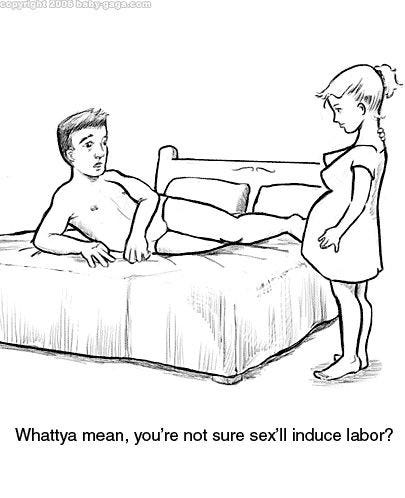
Unfortunately, upon examination, my cervix was still so high that not even the midwives could reach it! They had to call in the cavalry.
So in walked a serious looking doctor (white coat and all) who hoisted my legs up in stirrups and went digging with a speculum. Once the tape was tucked in nice and snug, I was taken to my bed in the maternity ward where I was to wait out the night and see what happened.
Nobody (medical professionals included) quite knows how a woman’s body will react to “the tape.” Some get over-stimulated and need to have the tape removed within a couple of hours, and others require another round of the tape after 24 hours and a still-green pineapple. I had done my reading and wondered where on the spectrum I would fall.
After bidding goodbye to my husband at 8pm (end of visiting hours), I lay back on the tough hospital mattress and tried to visualise my cervix opening like a blooming lily. (This is a very real recommendation you will find on The Internet, and some women swear by it. Of course, these women could have coincidentally used such a visualisation technique the night before they went into spontaneous labour and then made such an association, but I was a desperate and very pregnant woman who did not want to spend another 48 hours waiting for a baby that seemed determined to stay put. So bloom away, little cervix.)
Every couple of hours, a new midwife would come in and check on me, always asking the same question, “Any twinges yet?”
I would sadly reply with “No,” feeling more and more like a failure with each inflection.
And then, at about 3am, I was awoken by what felt like mild period cramps. Were these the twinges they were asking me about? I lay there waiting for the next “twinge” and noticed that each one was coming on stronger, and becoming more painful. They couldn’t be full-blown contractions, could they? I pulled out my phone and quickly downloaded a contraction-counter app and started timing them, while shooting my husband a brief message to say that something was happening, but I wasn’t sure what.
Using the app, I deduced that the “contractions” were coming every three minutes and lasting for about a minute. And they were getting so painful I could barely stay coherent enough to press the “contraction started” button when a new one arrived. When the app thrust the message “Time to go to the hospital!” in my face, I buzzed for the midwife.
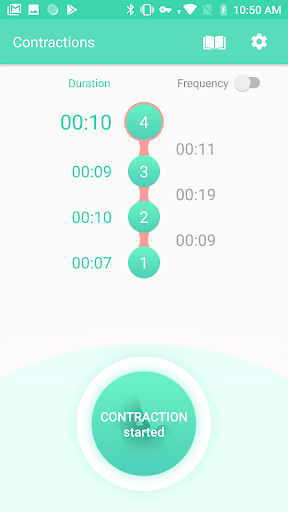
She strolled in and I breathlessly apprised her of the situation in less than three minutes before the next cramp/twinge/contraction hit.
“They can’t be contractions. They’re just tightenings. This is normal,” she said. “I’ll come back and check on you in an hour. Hang in there.”
At this point, I was convinced that these words were all synonyms for the same thing which meant imminent pushing and baby delivery! Rather than leaving me alone in bed in the maternity ward, I thought they should be rushing me to the birth suites, toot suite.
Now, there is something you should know about me. I’m a people pleaser, and am polite often to the point of my own detriment. And so, I started to begrudgingly say to the midwife, “Ok, I’ll see you in an hour.”
But then, as a new wave began to build, I realised that then and there, in that very moment, the little acrobat in my belly had only one advocate, and it would do her no good if that advocate was a spineless pushover. What if there was something actually wrong, and I let politeness trump the safety of my baby?
So instead, I said, “Look lady, I have a high pain threshold. I am sure these are full-blown contractions. I need to go over to the birth suites, ok?” (I still can’t quite remember whether I added the “lady” in there, but I like to think that I did.)
I didn’t realise it at the time, but that was my first act as a mother — to go against my heavily ingrained nature for the sake of my daughter’s health and safety.
Fortunately, the midwife accepted my plea and five minutes later we were walking the obscenely lit corridors of the hospital together, headed directly for the birth suites. Every three minutes, I had to pause and grasp the handrail as a new wave of ever-heightening pain washed over my entire body. My legs would tremble and I would see spots. (“Tightenings,” my arse.)
When we arrived, the midwife deposited me in an examination room and bid me goodbye. It was 4am, I was all alone in the room, and there were 45 seconds until the next wave. I was terrified. Surely, my cervix had magically descended and bloomed like a spring lily. Surely, I was minutes away from giving birth. Surely!
When a new crone-faced midwife strolled in, I was in the middle of another contraction, vomiting into a bag I found next to the examination table. She instructed me to lay back and spread my legs while she examined me, instructions that barely registered in my consciousness through the pain. As the wave receded, she uttered five all-too-familiar words that completely and utterly shattered me.
“I can’t reach the cervix.”
The birthing process is a delicate balance of multiple natural systems working together in a perfectly choreographed dance. The cervix gracefully descends and blossoms as the uterus begins contracting in a building crescendo that culminates in a symphony of sounds that are the mother’s groans giving way to baby’s cries.
It seemed that my earlier medical intervention had thrown a giant grenade into this graceful dance, and things were in complete disorder. My uterus was attempting to push my baby out through an opening that was still well and truly shut!
With very little sensitivity, the midwife informed me that “luckily for me,” most birthing suite rooms were currently empty, which meant I could hole up in one of those rather than be sent back to the maternity ward. With 30 seconds until the next wave, being sent back to maternity seemed tantamount to a death sentence. My whole body had begun shaking even between contractions now, and I felt on the verge of passing out.
Now, I had been to the birthing classes. I knew the different levels of pain management that were on offer during labour, all of which try and disrupt or muffle the pain signals in some way before they reach the brain. At the mild end are shots of water and/or electrical impulses in the lower back followed closely by happy gas. As you move towards the other end of the spectrum, shots of water are replaced by infusions of morphine. And instead of water injections in the back, a single injection into the cervical column delivers local anaesthetic to the space around the spinal nerves, effectively paralysing you from the waist down. (What a way to disrupt the signal!) This is known as an epidural.

When we were informed of these pain management options during our birthing classes, to my everlasting shame, I had internally scoffed at all the women in the world who had opted to have an epidural. How bad could the pain be that they wanted to unnaturally deliver their babies in an (albeit temporarily) paraplegic state?
My naive pregnant self had gone to bed every night after 37 weeks, visualising a serene labour in a candle-lit room infused with the scent of lavender while classical music drifted softly around me. My husband would be there, rubbing my back while I calmly meditated through each contraction. Finally, I would “breathe” my baby out, like some zen goddess adorned with a crown of daisies.
My arrogant expectation of the birthing process was so different from the reality that I may as well have visualised my baby being delivered to me on the back of angel wings.
I say all this to put into perspective the magnitude of the next moment.
As the stern midwife bluntly instructed me to follow her to the next room, the pain reached a point where me and my 0cm dilated cervix gasped to her, “I need an epidural!”
I’ll never forget the look on her face. Her expression was one of incredulous disdain as she dryly asked, “Are you serious?”
I felt about the size of an ant. Not only had I fallen well below my own expectations, but the arguably experienced midwife in front of me also thought I was woefully weak. I felt like I had completely failed the test before it had even started.
Labour of love
It was 5am when my husband rushed into my birth suites room and saw me standing hunched, hands on the elevated bed as my legs violently shook beneath me and I vomited into a bag (held by yet another midwife), wishing for death as another contraction racked my body. At this point, I was breathing in the gas (between retches) and using the TENS machine to send impulses into my lower back. Both did about as much to “disrupt” the pain signals as a stop sign would an avalanche.
When the contraction receded, I capitalised on the moment of faint lucidity, looked into the ashen face of my husband and told him I needed an epidural. He knew how vehemently opposed to it I was, and despite being completely taken aback by my state, still did the one thing I had made him promise me he would do.
He knelt down before me, struggling to make eye contact with my glazed vision and said, “Are you absolutely sure?”
All I could do was nod shakily at the floor as I prepared for another building contraction. He immediately sprung into action.
I don’t remember too much of the next hour as the pain reached crescendos that reduced me to an animal whose only goal was to survive. No time to create new memories. No time to take in the environment around me. It was a game of survival, of simply trying to make it from one dip between contractions to the next.
I do have a vague recollection of sitting on the hospital bed, bent forward to expose my naked back to the anaesthetist who was about to jam a big needle into my spine. As everyone around me urged me to stay still as a statue, a dim thought bubbled to the surface. There was no way I would be able to immobilise my instinct-driven body during a contraction enough to allow the doctor to do her jamming, which put me at risk of paralysis. And I didn’t care. The prospect of pain relief (that actually worked) irrationally trumped any threat of becoming a paraplegic.
After successful needle-jamming, the relief was almost immediate. I felt a cool sensation trickling down my spine, like someone had poured ice cold water down my back. Water that washed away the pain.
As another contraction built, I braced myself and felt… half nothing, half excruciating pain. The epidural had only half worked. I wasn’t paraplegic, I was monoplegic! But after a revisit from the anaesthetist, my epidural was remedied and ramped up. The trickle of water was now a gush that flowed every hour on the hour, keeping me in a pain-free state.
I could see again! I could talk! I could form actual sentences!
And so, instead of bouncing on a gym ball in a dark room, breathing through each contraction like I had imagined, I lay motionless and horizontal in a brightly lit hospital bed, completely unable to move anything below my waist. Two straps snaked around my bulging stomach which tracked my contractions and baby’s heart rate. Needles poked out of my arms and back to administer IV fluids and pain relief drugs. With each new freezing surge of the drug, I felt a wave of sleepiness wash over me. How strange it was to to go from a state where contractions were so painful that I thought I would surely pass out, to one where I could sleep through each one!
That sleepiness seemed to extend to my uterus as well. My contractions had slowed down in frequency and intensity, giving my cervix some time to sober up and come on down.

At about 12pm, a petite brunette with a perfect smile swooped in, ready to take charge. Our regular midwife had arrived.
Although diminutive in stature, Mikaela’s attitude and general presence were anything but. She was a force to be reckoned with, and I immediately felt at ease as she flashed me a big smile and asked how I was doing whilst simultaneously assessing the heart rate history and current vitals of me and bubs.
Mikaela knew how strongly I felt about pain relief, yet she did not question for a second my current pain-relieved state and I didn’t feel the slightest hint of judgement from her. Satisfied with our progress, she asked to examine me, and I braced myself for those dreaded five words. (I could almost telepathically feel my husband brace himself for the same thing.) Fortunately, she didn’t utter them.
But not-so-fortunately, she did say, “Ok, your cervix has come forward enough for me to reach it with my fingers, but it’s still really high.”
Then I saw her smile up at me from between my legs. “You are dilated though — I would say about 4cm, which is fantastic. I think we can go ahead and break your waters!”
The point of no return
Apparently while my cervix was actually starting to bloom, it was still in the wrong position. Giving nature another little nudge by piercing the protective amniotic sac was going to (hopefully) force it to assume the correct position. I was very nervous. Popping the protective bubble that currently housed my baby was essentially forcibly evicting her. And forcing her to create her own exit!
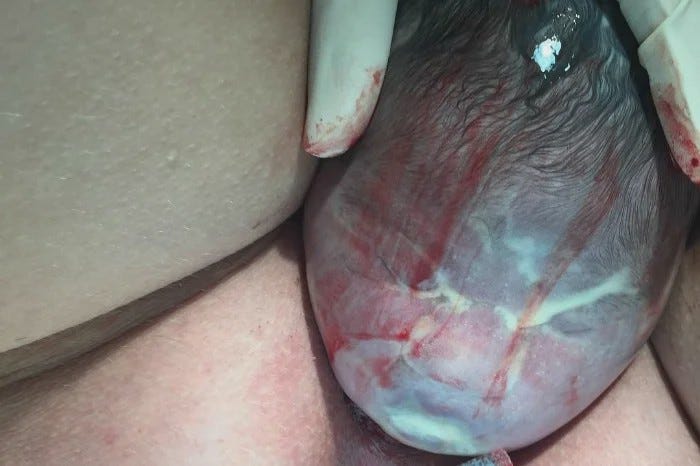
But I trusted Mikaela. And so, my also-nervous husband stood next to me and clasped my hand as she popped the bubble. While I couldn’t see what was happening down there, I could see my husband’s face. He wore an expression of horrified fascination as a large gushing sound emanated from my nether regions.
“There’s just… so much!!” he exclaimed. Even Mikaela seemed surprised at the sheer quantity of fluid that was rushing out of me.
“It’s completely normal, Julie,” she said, sensing my worry. “And it’s lovely and pink. No meconium here!”
I knew that this meant our little baby was still happily snug inside me, and not in any kind of distress, for she was still holding onto her little bowels. (That first tar-like poo that a baby does, once born, is a very special gift saved just for the parents.)
And then… we waited. And waited. For the magical 10cm number. And while my body was still having contractions pretty regularly, Mikaela decided to give nature another little nudge by supplementing my own natural oxytocin (the contraction-causing hormone) with some synthetic oxytocin.
I knew I was in the throes of what was referred to as the “cascade of intervention.” You see, once you start “helping” nature along, you can’t stop. In fact, “helping” often becomes “taking over,” which in the worst-case scenario culminates in an operation that literally bypasses the entire birth canal: a caesarean section. When push came to shove (no pun intended), I needed my body to be ready. I wanted to avoid that operating theatre at all costs.
With each examination, Mikaela reassuringly told me my cervix had both descended and dilated a little further. But was it happening fast enough? The clock starts ticking once waters have been broken, and I didn’t know whether I was winning or losing in this race against time.
It was about 2pm when Mikaela examined me for the fourth time that day and said four very different and welcome words.
“Your cervix is ready!”
My little flower of a cervix had finally come on down and had bloomed nice and wide, ready to eject its little tenant.
“Ok, I’m going to turn off the epidural drip soon and we’re going to get you to start pushing at 3pm,” Mikaela informed me, as she began raising the head of the bed so that I was in a half-sitting position.
Shit was about to get real.
Thirty seconds
At 3pm, I still couldn’t feel much. I could twitch my legs and faintly feel contractions, but I had absolutely no sensation in my birth canal, which my darling baby’s head was apparently bearing down upon. How the hell could I push something I couldn’t feel?
Mikaela calmly assured me that my lack of feeling was normal with an epidural and that pushing was still possible.
“I’ll coach you through each push,” she said, as my husband helped her pull my lifeless legs up into stirrups, as if they were arranging a mannequin for a store window.
Assuming her position between my legs at the foot of the bed, Mikaela then put her fingers inside me to touch my baby’s head and said, “Now, I want you to focus on the faint sensation of my fingers. Grip your legs behind your knees, tuck your chin to your chest, breathe in, and on the next contraction, PUSH!”
When the needle tracking my contractions started to arc higher, I did as I was told. Legs gripped. Chin tucked. PUSH!
I pushed as hard as I could, without any sense of progress, without any sensation at all. Was anything even happening?
My husband gripped my shoulder as he cheered me on. “Yes, that’s it Juliette. Good! Keep pushing!! Keep pushing!!”
“Is it working??” I cried desperately.
Mikaela confirmed, “Yes! Her head is closer. You’re doing great Julie!”
I twisted my neck to glance behind me at the monitor that continuously tracked my contractions and baby’s heart rate. During that last contraction, I saw that her heart rate had dipped a little. I tried not to worry. My husband and I knew to expect this. We were told that contractions close to delivery can compress the baby’s head, causing their heart rate to slow. “Think of it like your baby taking a big breath before being dunked underwater. And when the contraction is over, they resurface for air” was how it was explained to us during the birthing classes.
The squiggly lines on the screen told me it sure took my baby daughter a heck of a long time to resurface for air. My worry mounted.

On the next contraction, Mikaela calmly but urgently instructed me to push as hard as I could. I focused every fibre of my being into that next push. I tensed every part of my body that I could feel, and tried to imagine and zero in on where her little head must be, pouring all my energy into that point as I strained until I saw spots.
Mikaela and my husband urged me on as I heard my baby’s heart rate begin to drop with the contraction. When the contraction crested and receded, I waited for her heart rate to return to normal.
It didn’t.
I screamed at my husband, “Please, tell me it’s going back up!”
His stricken face, staring at the screen behind me, spoke volumes. Although the epidural had long since ended, I felt a chill run down my spine. My heart was in my mouth as a piercing alarm began to sound.
Mikaela stood up and fixed me with an urgent stare. “Now, stay calm Julie, but I’m going to call some more people in here because baby isn’t recovering as quickly as we would like.”
Nothing about that sentence made me calm.
I was on the verge of hysteria and tears began streaming down my face. Was this really happening?? Was my baby going to die???
In a matter of seconds, the room filled with a throng of people that instantly parted to make way for a white-coated woman in her 50’s who wore an expression of confident authority. She was panting from the exertion of rushing to our room.
Whilst catching her breath, she addressed the room full of doctors, nurses and midwives. “Everyone, be quiet! Ok, this is what we are going to do. Is theatre ready? Ok, good. Is the resuscitation bed ready? Ok, good. Someone turn off that alarm.”
Utterly distraught, I was in the middle of begging my husband to tell me her heart rate was going back up when the doctor turned to me and said, “Ok Julie. I need you to look at me. Focus on me. We’re going to get your daughter out, OK? But I need your help.”
I was hysterical beyond all reason. I felt stuck in some alternate reality. An hour ago, my husband I were laughing together, eager to meet our brand new baby daughter. And now, after carrying her for so long, I was terrified my beautiful little acrobat might die before she had ever even lived.
“Is she going to die??” I cried. “Please, do whatever you need! Please, just cut her out of me!!”
The doctor did not shift her gaze from mine or even blink. “Julie, she is NOT going to die. But it is important that she comes out right now, so we need to help your next push along ok? I’m going to do an episiotomy, and then use forceps to guide her out. Do I have your permission?”
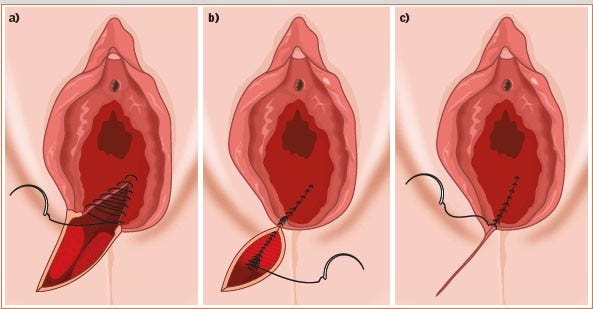
I was in utter disbelief that she was satisfying some legal formality in the midst of a life-and-death situation. (Of course, with the benefit of calm hindsight, I understand the necessity of such a step. But in the moment, it seemed almost callous.)
“Yes, yes!” I shrieked. “Do whatever you need! Please, we’re wasting time!!”
The moment she had my consent, she broke eye contact with me, simultaneously accepted a scalpel from the nurse in her left hand and used her right to manoeuvre the overhead fluorescent light down to focus between my legs.
“Making the incision now,” she said to the room. Then she fixed me with a piercing stare and said, “Ok, on this next contraction, I need you to push with everything you have, Julie. Everything you have.”
The room instantly quietened. All the doctors and nurses and midwives in the room were staring at me, each wearing an expression of dire anticipation. The air felt heavy with solemn urgency. It had come down to this. My daughter’s little life was in my hands. On whether I could physically push well enough in the next 30 seconds.
My husband was bent over so that his cheek was touching mine, his hand tightly gripping mine. I knew he was willing all the strength he had into me.
As the contraction started building, he started whispering a prayer in my ear, and I could feel his tears on my cheek. I started praying with him, our whispers washing over each other as we begged God to keep our daughter safe.
“Ok, Julie. Here it comes. Ready?”
I took the deepest breath. Gripping the back of my knees, chin tucked to my chest, I exhaled and pushed. My eyes squinted with the strain, my neck muscles knotted in ropes, my arms became taught with tension, my abs rigid as stone. I imagined every cell in my body aligning and tensing in unison, all systems diverting energy to one cause: the safe delivery of our baby daughter. My vision went cloudy as blood vessels in my eyes and neck burst. A guttural sound left my throat with the last of my breath.
And still no cry of a baby.
I began sobbing with futility, begging them, “Please stop waiting! It’s not working! Please, just cut her out of me!”
I barely registered the smile on Mikaela’s face as she said, “But Julie, it is! She’s almost here. Look, feel her!”
Feeling like they were still wasting precious time, I reached my hand down between my legs and touched what felt like wet, matted fur.
“But why isn’t she crying???”
With a hint of a smile, the doctor responded with, “Her mouth isn’t out yet honey! But she’s coming! OK, BIG next push!!” (Based on the smiles, I think at that point, everyone else in the room must have understood that medically, things were going to be ok. I didn’t pick up on this at the time, dosed as I was with a hysterical cocktail of grief, worry and desperation.)
It was on the last push during that crucial contraction that I heard a wet, smacking, slopping kind of noise. A split second later, the doctor swiftly deposited this slippery, slimy, pink and red little creature on my naked chest. My daughter’s limbs were all tucked up against her body as she lay on my breast, like some compact tree frog wedged behind a drain pipe.
She was quietly and calmly gazing up at me, her eyes huge dark obsidian pools, her eyebrows slightly raised in gentle curiosity as if to ask, “What was all the fuss about?”
As I tightly wrapped my arms around her, I felt a cascade of emotions. Gratitude, for her life. Amazement, that she was actually real. Disbelief, that this living, breathing little thing had just been inside my body. And most of all, I felt an overwhelming sense of pure love.
They all say that there is an almost primal moment at birth, where the unbreakable bond between mother and child is forged. From that moment forward, the mother’s very happiness is tied to the happiness of her child, their lives inextricably linked.
Given my lifelong protest against having children, I had spent the past nine months harbouring a secret and shameful worry that I would not feel such a connection. Sure, I knew that hundreds of thousands of years of evolution were on my side, and it was likely I would feel some sense of protectiveness towards my child. But what I felt in that moment transcended biology. It went beyond blood and tissue and instinct and survival. The love that I felt was an artefact that belongs in the same realm as the soul.
I felt more tears against my cheek, but knew that they were tears of happiness as my husband fiercely hugged his new little family. He was crying. I was crying. How ironic that the only one not crying in this trio was our little newborn baby, who was still looking curiously up at us.
“Do we have a name?” Mikaela asked.
As I looked down at my daughter, I knew she wasn’t a Trinity. Nor was she a Marigold or Everleigh. After the life-and-death ordeal that was my daughter’s entrance to the world, it seemed fitting her namesake imply the kind of strength that stood the test of thousands of years. Smiling, I turned to face my husband and said, “It’s the one you thought. She can’t be anything else.”
He was smiling when he nodded back at me before proudly addressing the room as a new father. “Everyone, meet Aurelia.”
Much of the next medical part of the birth passed in a blur, focused as we were on our little “Rae.” Mikaela delivered the placenta, and then another nice doctor sat down and started stitching up the massacre between my legs.
My husband still hugged me tightly as we just stared down at our daughter, completely and utterly spellbound. When she began grubbing and grunting her way over to my right breast in search of a feed, we chuckled. Mere minutes old and already prioritising food!
That’s our girl.
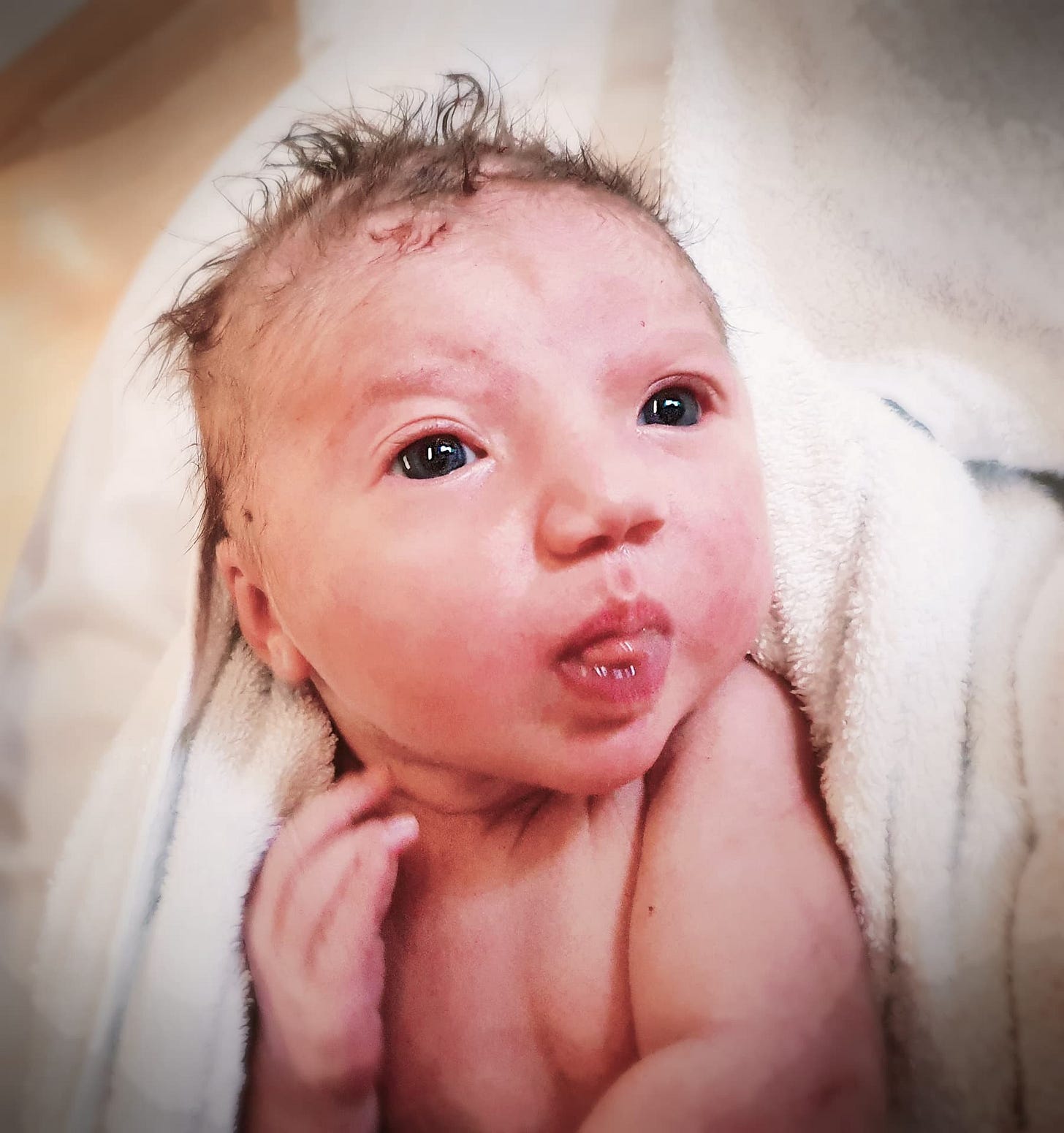
The aftermath
In the weeks that followed, I replayed the delivery in my mind over and over again, agonising over every deviation from the natural course of things. If only I had been stronger, I thought. If only I had been braver. Maybe I could have avoided the epidural. Maybe I could have pushed my daughter out faster.
But one morning, while gazing down at my angelic sleeping daughter, I had a sudden revelation. Her features were soft with the kind of peace only children’s dreams can bring. She had no memory of her traumatic birth, nor had it negatively impacted her in any way.
The memories and scars were all mine.
And that trauma was actually a blessing in disguise. It had revealed the true depths of my love for her. In those dire moments when I had begged the doctors to literally cut her out of me, I had given no thought at all to my chances of survival.
I had been prepared to sacrifice my life for hers.
It’s a sacrifice any parent would vow to make for their child, but luckily, few are ever put to the test. And if I had remained untested, I would forever question just how far I would go for my child. But the circumstances of her delivery had absolved me from that lifetime of doubt. And so, while the birth of our daughter had not gone at all as I had imagined, I know now that it had all happened exactly as it should.
For out of the storm was born our Aurelia, our eternal Rae of sunshine.



